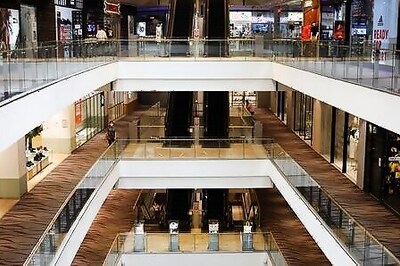
views
Bengaluru: Chandrayaan2, India’s second mission to the Moon that had the ambitious goal of putting a lander on the lunar surface, is still able to take pictures of the lander through the orbiter after almost once every four hours. The lander, named Vikram, lost contact with the main lunar craft (and to the ground station) minutes before its scheduled landing on Saturday.
“The first pictures that we got on Saturday seemed to show that it (Vikram) was still on its feet, but it was tilted. There are slim hopes of re-establishing communication, but that does not mean we don’t try. We do try every time the orbiter goes over it,” said a scientist on conditions of anonymity.
Going by the tilt of the lander, scientists are yet to make out if there is any major damage on it. While it is designed to take some amount of shock, for example, if the lander had had a free-fall for some distance, it still is equipped to bear some amount of shock. Its ‘legs’ are fitted with 'shoes' that almost act like a helmet and its mechanical systems are supposed to be able to bear that shock.
The Indian Space Research Organisation (ISRO) is waiting to get better data from the pictures — the tilt may have been caused by elongated shadows of the Sun’s rays too, so scientists are waiting for the rays (the degree of the rays) to change to some extent so they would get better insights on the actual damage caused. This data may take a day or two more, as it depends on the movement of the Moon’s orbit to the Sun.
While mechanical systems inside the lander may still be in working condition, considering that it has landed on its legs. However, there are other concerns. If it has fallen in a slanted way, though the mechanical systems may be intact, the solar panels may have been damaged.
Solar panels are very delicate — like glass — and they may not only break, but they could short-circuit the electrical systems within. "Electrically, it can create confusion to all systems if it has shorted. And if the panels are damaged, there is no power and that leads to other cascading. Moreover, if any of the damage is around the area where the rover ‘Pragyan’ is located, that causes other problems,” the scientist said. Chandrayaan-2 comprises an orbiter, lander (Vikram) and rover (Pragyan).
The team has slim hopes but keeps telling itself that there is no harm in looking for signals every time the orbiter goes over the spot where the lander is located at present — if all mechanical systems are doing fine, there may still be some faint signals to work with.
“Nothing wrong in trying to activate it, nothing wrong in looking for signals,” is the premise on the assumption that the lander is still in one piece. However, data from as late as Monday afternoon shows it may not be so.
The lander was supposed to land at a pre-designated spot between two craters, but the deviation from path on September 7 may have put it off-mark by as much as 5km, but this estimate is still being correlated.
The scientists have mulled over whether they must move the orbiter closer to the Moon to get better pictures — theoretically, it can move as much as 50 or even 30km from the lunar surface. But this would involve its own risks. It is not a risk they may want to take just to locate the lander’s status — they would be more inclined to take such a risk if they can be more confident of restoring communication with the lander.
“We are aware that the lander developed a problem when it was closer to the Moon. Until a certain distance, it was functioning fine. If that malfunctioning repeats, that would create more problems for the orbiter. Secondly, if they are able to navigate the orbiter closer, but aren’t able to restore it to its farther distance, it would be a bigger problem,” the scientist told News18.
At present, after communication with the lander was lost, ISRO had stated that the orbiter, which is 95 per cent of the science of the mission, would be able to last much longer. Its lifespan was enhanced from one year to all of seven years. If ISRO took the risk of manouvering the orbiter closer to the Moon and something goes wrong, then this 'face-saver' part of the mission would also get botched up — the space community is taking heart in the fact that at least it has one lunar craft ‘alive’.
"It’s a face-saving system right now. We have said the mission is still a 95 per cent success because of this. If, the next day, we touch this, that's not a prudent exercise. So we will think many times before taking such a risk… Is it worth taking such a risk in first week itself?” the scientist added.
The space agency is wondering if it should use resources from other space agencies for better data on ‘Vikram’. For instance, NASA’s Lunar Reconnaissance Orbiter (LRO) is closer to the Moon than Chandrayaan-2, and the LRO's data was also partly used by ISRO earlier to zero in on its landing spots. It may decide on its next course of action in a couple of days, once it gets better data from its own orbiter.




















Comments
0 comment